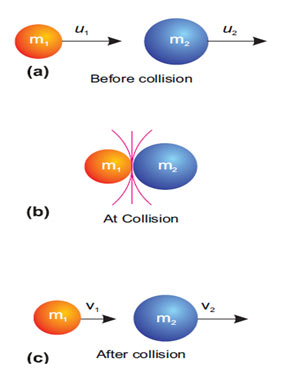- Books Name
- Science Made Easy Science Book
- Publication
- Science Made Easy
- Course
- CBSE Class 9
- Subject
- Science
Law of Conservation of Momentum
→ When two (or more) bodies act upon one another, their total momentum remains constant (or conserved) provided no external forces are acting.

• Initial momentum = Final momentum
Suppose, two objects A and B each of mass m1 and mass m2 are moving initially with velocities u1 and u2, strike each other after time t and start moving with velocities v1 and v2 respectively.
Now, Initial momentum of object A = m1u1
Initial momentum of object B = m2u2
Final momentum of object A = m1v1
Final momentum of object B = m2v2
so, Rate of change of momentum in A,
F1 = (m1v1 - m1u1)t = m1(v1 - u1)/t ....(i)
Rate of change of momentum in B,
F2 = (m2v2 – m2u2)t = m2(v2 - u2)/t ....(ii)
We know from 3rd law of motion,
F1 = −F2
So, m1(v1 - u1)/t = - m2(v2 - u2)/t
⇒ m1v1 – m1u1 = -m2v2 + m2u2
⇒ m1u1 + m2u2 = m1v1 + m2v2
Thus, Initial momentum = Final momentum
Example 1: A bullet of mass 20 g is fired horizontally with a velocity of 150 m/s from a pistol of mass 2 kg. Find the recoil velocity of the pistol.
Solution
Given, Mass (m1) of bullet = 20 g = 0.02 kg
Mass (m2) of pistol = 2 kg
Initially bullet is inside the gun and it is not moving.
∵ Mass = m1+m2 = (0.02 + 2) kg = 2.02 kg
and u1 = 0
∴ Initial momentum = 2.02 × 0 = 0 ....(i)
Let the velocity of pistol be v2 and v1 for bullet = 150
∴ Final momentum = m1v1 + m2v2 = 0.02×150 + 2v2 ...(ii)
We know that,
Initial momentum = Final momentum
∴ (0.02×150)/100 + 2v2 = 0 [From equations (i) and (ii)]
⇒ 3 + 2v2 = 0
⇒ 2v2 = −3
⇒ v2 = −1.5 m/s
(−)ve sign indicates that gun recoils in direction opposite to that of the bullet.
Example 2: Two hockey players viz A of mass 50 kg is moving with a velocity of 4 m/s and another one B belonging to opposite team with mass 60 kg is moving with 3 m/s, get entangled while chasing and fall down. Find the velocity with which they fall down and in which direction?
Solution
Given,
mA = 50 kg, uA = 4 m/s
mB = 60 kg, uB = 3 m/s
Initial momentum A = mAuA = 50 × 4 = 200 kgm/s
Initial momentum B = MBuB = 60 × 3 = 180 kgm/s
∴ Total initial momentum = 200 + 180 = 380 kgm/s ....(i)
Final momentum = (mA + mB)v = (50 + 60)v = 110v ....(ii)
According to the law of conservation of momentum,
380 = 110v
⇒ v = 380/110 = 3.454 m/s
Questions -
1. State two effects of force.
2. Scientist who first conducted experiment to form the base for Newton's first law of motion.
3. If first law of motion holds true, why does a ball rolling on ground stop on its own?
4. What would happen if there was no friction on the Earth?
5. Why is it dangerous to jump out of a moving bus?
6. Define force and its various types. What is its unit?
7. What is the negative effect of friction on your shoe soles?
8. You are applying force on the pan of single pan weighing balance and the pointer points to 100 g. What is the force in newtons applied by you?
9. An athlete always runs some distance before taking a jump. Why?
10. A cricket ball of mass 70 g moving with a velocity of 0.5 m/s is stopped by a player in 0.5 s. What is the force applied by the player to stop the ball?
11. In a cricket match, why does a player lower his hands slightly while catching the ball?
12. Two cars having masses in the ratio 4 : 5, accelerate in the ratio 2:3. Find the ratio of forces exerted by each of them.

 Science Made Easy
Science Made Easy
